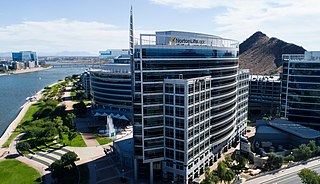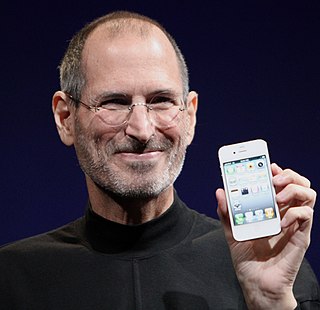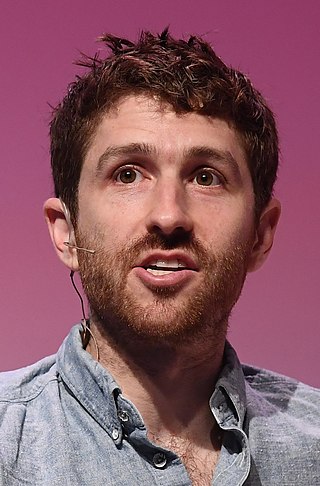
Apple Inc. is an American multinational corporation and technology company headquartered in Cupertino, California, in Silicon Valley. It designs, develops, and sells consumer electronics, computer software, and online services. Devices include the iPhone, iPad, Mac, Apple Watch, Vision Pro, and Apple TV; operating systems include iOS, iPadOS, macOS, watchOS, tvOS, and visionOS; and software applications and services include iTunes, iCloud, Apple Music, and Apple TV+.

Guy Takeo Kawasaki is an American marketing specialist, author, and Silicon Valley venture capitalist. He was one of the Apple employees originally responsible for marketing their Macintosh computer line in 1984. He popularized the word evangelist in marketing the Macintosh as an "Apple evangelist" and the concepts of evangelism marketing and technology evangelism/platform evangelism in general.

Carl Sassenrath is an architect of operating systems and computer languages. He brought multitasking to personal computers in 1985 with the creation of the Amiga Computer operating system kernel, and he is the designer of the REBOL computer language, REBOL/IOS collaboration environment, the Safeworlds AltME private messaging system, and other products. Carl was a Principal Engineer at Roku, Inc. until his retirement in November 2023.

Gen Digital Inc. is a multinational software company co-headquartered in Tempe, Arizona and Prague, Czech Republic. The company provides cybersecurity software and services. Gen is a Fortune 500 company and a member of the S&P 500 stock-market index. The company also has development centers in Pune, Chennai and Bangalore. Its portfolio includes Norton, Avast, LifeLock, Avira, AVG, ReputationDefender, and CCleaner.

eWorld was an online service operated by Apple Inc. between June 1994 and March 1996. The services included email, news, software installs and a bulletin board system. Users of eWorld were often referred to as "ePeople."

The Macintosh, later rebranded as the Macintosh 128K, is the original Macintosh personal computer, from Apple. It is the first successful mass-market all-in-one desktop personal computer with a graphical user interface, built-in screen, and mouse. It was pivotal in establishing desktop publishing as a general office function. The motherboard, a 9 in (23 cm) CRT monochrome monitor, and a floppy drive are in a beige case with integrated carrying handle; it has a keyboard and single-button mouse.
Eazel was an American software company operating from 1999 to 2001 in Palo Alto and then Mountain View, California. The company's flagship product is the Nautilus file manager for the GNOME desktop environment on Linux, which was immediately adopted and maintained by the free software movement. As the core of Eazel's business model, it is an early example of cloud storage services in the form of personal file storage, transparently and portably stored on the Internet. Renamed to Files, this application continues to be a centerpiece of some free Linux-based desktop environments.
The Apple community is the users, media, and third party companies interested in Apple Inc. and its products. They discuss rumors, future products, news stories, and support of Apple's products. Apple has a cult-like following, especially for the Apple II, Macintosh, iPod, iPhone, and luminary staff members. The personal computer revolution, mixed with Apple's vertical integration of its products and services, has increased popularity. Apple's corporate policy of extreme secrecy about future products intensify interest in the company's activities.

Apple Inc., originally Apple Computer, Inc., is a multinational corporation that creates and markets consumer electronics and attendant computer software, and is a digital distributor of media content. Apple's core product lines are the iPhone smartphone, iPad tablet computer, and the Macintosh personal computer. The company offers its products online and has a chain of retail stores known as Apple Stores. Founders Steve Jobs, Steve Wozniak, and Ronald Wayne created Apple Computer Co. on April 1, 1976, to market Wozniak's Apple I desktop computer, and Jobs and Wozniak incorporated the company on January 3, 1977, in Cupertino, California.
A Macintosh User Group (MUG) is a users' group of people who use Macintosh computers made by Apple Inc. or other manufacturers and who use the Macintosh operating system (OS). These groups are primarily locally situated and meet regularly to discuss Macintosh computers, the Mac OS, software and peripherals that work with these computers. Some groups focus on the older versions of Mac OS, up to Mac OS 9, but the majority now focus on the current version of Mac operating system, macOS.

Steven Paul Jobs was an American businessman, inventor, and investor best known for co-founding the technology company Apple Inc. Jobs was also the founder of NeXT and chairman and majority shareholder of Pixar. He was a pioneer of the personal computer revolution of the 1970s and 1980s, along with his early business partner and fellow Apple co-founder Steve Wozniak.
Evangelism marketing is an advanced form of word-of-mouth marketing in which companies develop customers who believe so strongly in a particular product or service that they freely try to convince others to buy and use it. The customers become voluntary advocates, actively spreading the word on behalf of the company.

The Berkeley Macintosh Users Group, or more commonly "BMUG", was the largest Macintosh User Group. It was founded in September 1984 by a group of UC Berkeley students including Reese Jones and Raines Cohen as a focal-point for the nascent Apple Macintosh user community. With more than 13,000 members, or "BMUGgers" at its peak in 1993, the group was the largest, and generally understood to be the most important, Macintosh users group. A few of the notable members include John "Captain Crunch" Draper, the Sultan of Brunei Hassanal Bolkiah, notorious murderer Enrique Zambrano, early hacker-chaser Cliff Stoll, Inktomi founder Eric Brewer, and may prominent computing journalists like John Dvorak, Ilene Hoffman, Leo Laporte and Adam Engst. An example of the group's omnipresent blue-floppy-disk lapel pin is held in the Smithsonian Institution's American History collection. BMUG's history and activities were closely linked with the MacWorld Expo meetings, traditionally held in San Francisco each January and Boston each August.

Elizabeth Jocelyn "Jake" Feinler is an American information scientist. From 1972 until 1989 she was director of the Network Information Systems Center at the Stanford Research Institute. Her group operated the Network Information Center (NIC) for the ARPANET as it evolved into the Defense Data Network (DDN) and the Internet.

Susan Diane Wojcicki is an American business executive who was the chief executive officer (CEO) of YouTube from 2014 to 2023. Her net worth was estimated at $765 million in 2022.

The Apple User Group Connection (AUGC) was established in 1985 by Apple and led by Apple employee Ellen Petry Leanse. AUGC was formed in response to concerns from users in community user groups that, with release of the Macintosh, development for existing Apple II and Apple III computers was compromised. The idea was for Apple to share information with its user community directly, rather than through the more traditional support and distribution channels. The organization successfully encouraged Apple to pursue early internet technology such as bulletin board systems and ARPANET.

Alex Stamos is an American computer scientist and adjunct professor at Stanford University's Center for International Security and Cooperation. He is the former chief security officer (CSO) at Facebook. His planned departure from the company, following disagreement with other executives about how to address the Russian government's use of its platform to spread disinformation during the 2016 U.S. presidential election, was reported in March 2018.

Tristan Harris is an American technology ethicist. He is the executive director and co-founder of the Center for Humane Technology.
Camille Hearst is a female African-American entrepreneur and innovator, credited in several online news publications for her decades-long contribution to the technology, social network, digital music service and product design sectors. In addition, she is recognized as a leading woman of color in entrepreneurship. In 2016, she broke barriers as a Women C.E.O. and a founder of color with her startup, Kit.


















